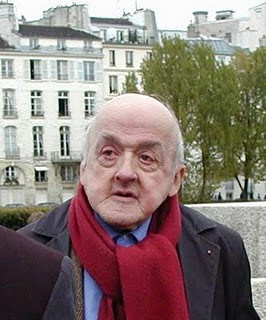Memoir of Nazi Terrors Against Homosexuals
French-born Pierre Seel came out of the closet at the age of 58 to bear witness to the Nazi deportation of homosexuals during WWII. After years of anguished silence, his powerful memoir recalls the details of his arrest and torture by the Gestapo and his horrific experiences at a concentration camp in Nazi-occupied Alsace, where homosexuals were the most despised of prisoners.
After the trauma he had endured at the hands of the Nazis as a homosexual, he tried for years to deny his true nature, even to the point of getting married and having children. That marriage was a failure. But in 1981, outraged by a prominent bishop's characterization of homosexuals as "sick," he became inspired with a sense of obligation to obtain recognition for what had happened to some 350,000 homosexuals during the war, and his public statements became a cause célèbre in France.
In 'I, Pierre Seel, Deported Homosexual: A Memoir of Nazi Terror' (1995), Seel narrated his story to Jean Le Bitoux, a French writer, journalist and gay activist. In it, he publicly airs the long-overlooked tragedy of the Nazi persecution of homosexuals. Seel’s account of his suffering and his plea for justice are heartrending in their dignified restraint, even though Seel had himself been tortured and raped with a wooden pole by the Nazis.
Below is an excerpt from his book, which has been translated into German, Spanish and English. I warn you that it is difficult to read.
"Days, weeks, months wore by. I spent six months, from May to November 1941, in that place, where horror and savagery were the law. But I've put off describing the worst ordeal I suffered. It happened during my earliest weeks in the camp and contributed more than anything else to making me a silent, obedient shadow among the others. One day the loudspeakers ordered us to report immediately to the roll-call site. Shouts and yells urged us to get there without delay. Surrounded by SS men, we had to form a square and stand at attention, as we did for morning roll call. The commandant appeared with his entire general staff. I assumed he was going to bludgeon us once again with his blind faith in the Reich, together with a list of orders, insults, and threats – emulating the infamous outpourings of his master, Adolf Hitler. But the actual ordeal was far worse: an execution.
Two SS men brought a young man to the center of our square. Horrified, I recognized Joe, my loving friend, who was only eighteen years old. I hadn't previously spotted him in the camp. Had he arrived before or after me? We hadn't seen each other during the days before I was summoned by the Gestapo. Now I froze in terror. I had prayed that he would escape their lists, their roundups, their humiliations. And here he was, before my powerless eyes, which filled with tears. Unlike me, he had not carried dangerous letters, torn down posters, or signed any statements. And yet he had been caught and he was about to die. What had happened? What had the monsters accused him of? Because of my anguish I have completely forgotten the wording of the death sentence.
Then the loudspeakers broadcast some noisy classical music while the SS stripped him naked and shoved a tin pail over his head. Next they unleashed their ferocious German shepherds upon him: the dogs first bit into his groin and thighs, then devoured him right in front of us. His shrieks of pain were distorted and amplified by the pail in which his head was trapped. My rigid body reeled, my eyes gaped at so much horror, tears poured down my cheeks, I fervently prayed that he would black out quickly.
Since then I sometimes wake up howling in the middle of the night. For fifty years now that scene has kept ceaselessly passing and repassing through my mind. I will never forget that barbaric murder of my love – before my eyes, before our eyes, for there were hundreds of witnesses. He was sentenced to be eaten alive because he was homosexual. Why are they still silent today? Have they all died? It's true that we were among the youngest in the camp and that a lot of time has gone by. But I suspect that some people prefer to remain silent forever, afraid to stir up the hideous memories, like this one, among so many others.”
Pierre Seel died of natural causes in November 2005, but his chilling tale lives on in infamy. In 2008 the municipality of Toulouse posthumously renamed a street in his honor. The sign reads: Rue Pierre Seel – Déporté français pour homosexualité – 1923-2005.
His memoir continues to inspire people whenever it is read. Available in print and Kindle editions.
Role models of greatness.
Here you will discover the back stories of kings, titans of industry, stellar athletes, giants of the entertainment field, scientists, politicians, artists and heroes – all of them gay or bisexual men. If their lives can serve as role models to young men who have been bullied or taught to think less of themselves for their sexual orientation, all the better. The sexual orientation of those featured here did not stand in the way of their achievements.
Thursday, August 4, 2011
Subscribe to:
Post Comments (Atom)



Thank you for sharing this, and all the other stories. I applaud your commitment to our history. Thank you. Thank you so very much.
ReplyDelete